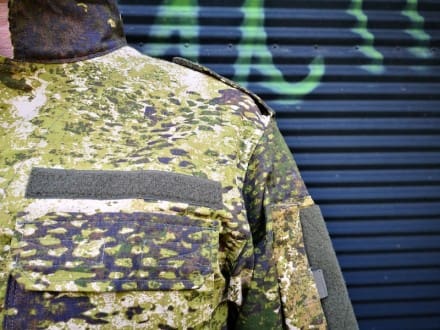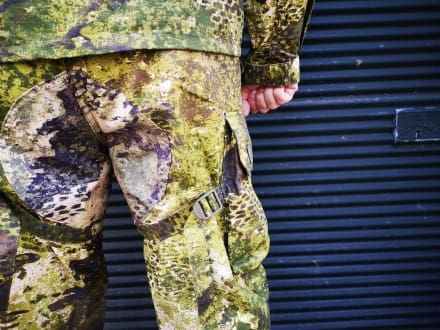PHANTOMLEAF is a new camouflage pattern on the market – we saw it first at Enforce Tac and IWA 2019. We have recently presented the first combat clothing in the camouflage pattern. HERE the review of the Leo Köhler set in PHANTOMLEAF. And we wanted to know what the Camo can do? HERE it goes to the first field test. Now we wanted to know who is behind PHANTOMLEAF. Florian Lenz tells us where PHANTOMLEAF comes from, what it can do and what is to come.
SPARTANAT: PHANTOMLEAF has now presented its first civilian camouflage pattern. What can WASP II Z3a do? Who should use it?
PHANTOMLEAF: As you can see: It can do camouflage and deception. ? The background is simple: We received many inquiries about our patterns from the retail market. However, as we reserve some camouflage patterns to the authorities, what will not be changed in future, we have decided to develop a free-for-sale model for the civilian market. This took some time, but now the effect meets our quality standards. The area of ??application is the area defined in our system as zone “Z3a”: “Growth without snow cover”. This means high vegetation wich is transferred in a pattern with appropriate structure formation, light input as well as predominantly green tint. – see. our website: https://www.phantomleaf.de/tarnsystem/.
SPARTANAT: PHANTOMLEAF has been haunting the country for a long time, but you have been working very secretively for the public. What are you doing?
PHANTOMLEAF: In our understanding, this concept of confidentiality fits well with the needs of the special-forces units for which we work mainly. Our goal is to provide bespoke camouflage solutions for often very specific camouflaging problems on land, sea and in the air to meet the specific needs of our users. Most of it is confidential, which I ask for your understanding. This is where camouflage and our loyalty to our clients begin.
SPARTANAT: What is the difference between a government and a civilian model? WASP II Z3a is marked with “CIV” in the logo.
PHANTOMLEAF: I would prefer to talk about systems for the government market and systems for the retail market. Both have different needs in detail. Examples include things such as deployment distance to the reconnoitering opposite, tactical behavior and threat situation called. These are reflected, e.g. in the geometry of the camouflage pattern or thermal camouflage properties, the material properties (e.g., flame retardancy) and friend-foe detection, as well as the cutting of the readymade items. In addition, our camouflage patterns marked CIV are freely negotiable. Patterns intended for authorities are only delivered to selected partner companies: https://www.phantomleaf.de/partner/. The protection of our customers is important to us, so that we create both contractual and in the labeling (impression “CIV”) commitment with these partners. That clear handling easy for everyone.
SPARTANAT: How did you come up with the idea of entering the camouflage industry in Germany?
PHANTOMLEAF: I have been in camouflage for about 30 years – primarily to solve a problem, not to use it economically. The trigger is a personal, unpleasant, which I will not go into here. In doing so, I discovered a general principle for pattern generation, which has since been patented. The camouflage patterns produced with this have the significant advantage over various backgrounds of significantly reducing the recognizability of the camouflaged object. Furthermore, they are tailored to the size and geometric relationships of this object. Of course, this clearly increases the flexibility of the user: on the one hand, when moving from different backgrounds to, on the other hand, when he is under threat of reconnaisance from different angles. The latter will, in my estimation, in future be increased by automation such as e.g. using drones. Due to the achievable, highly effective results with these algorithms, I founded the PHANTOMLEAF GmbH in 2008 in order to make this invention usable for the protection of persons for whom I wanted to do something. Meanwhile, this company acts as a development office and Mr. Ulrich Krätzschmar (RECON-COMPANY) and I have together founded the PHANTOMLEAF 4USE GmbH in order to optimally shape the growing production and distribution of the original PHANTOMLEAF products for our customers. We see ourselves as an international company – with “made in germany” roots. This is reflected by our numerous specialist dealers: https://www.phantomleaf.de/handel/. These companies listed on our website also have a contractual obligation to strictly observe the market segmentation in authorities and retail markets for the protection of our government customers.
SPARTANAT: How do you approach the planning of a pattern with PHANTOMLEAF? What demands do you place on you?
PHANTOMLEAF: The approach is very individual, depending on the client approaching us, the object to be camouflaged, and the tactical circumstances such as e.g. place and time of operation. In any case, the systemic approach is important to us: In our experience not only a camouflage pattern should be created, but a coherent overall concept right down to a totally and systemically product design optimized for camouflage: It begins with materials selection, goes over the camouflage pattern, up to cut management and other points to deal with. We have the experience, that such a consequent approach increases the performance of the camouflaged system compared to only dealing with the invention of a pure camouflage pattern. In the end, we definitely want to have a solution for our customers that meets their needs as close to 100% as possible. Since we mostly deal with complex systems at the end, we work together with our partners from the beginning of system development. Our main focus is the “soldier system”.
SPARTANAT: WASP II Z3a is, so to speak, the “green” pattern in the new PHANTOMLEAF line. What else is there to do?
PHANTOMLEAF: Next, a “brown” version is planned: WASP II Z2. It is suitable for regions with low, especially semi-desert-like growth: https://www.phantomleaf.de/tarnsystem/. But we have the experience that this colorit can also serve well in autumnal winter areas, for example in Central Europe. Also envisioned is a “gray” variant Z4 designed for urban / man made environments.
SPARTANAT: Will there be all the gear in the new PHANTOMLEAF WASP II samples? What’s up?
PHANTOMLEAF: Thank you for asking this question. Already now many inquiries reach us. The answer is yes. There will be many articles in the near future, from head to toe, so to speak. Of course also suitable gear and bags.
Florian Lenz, medical doctor, specialist in psychiatry and psychotherapy,
Managing Director of PHANTOMLEAF GmbH and together with Mr. Ulrich Krätzschmar of PHANTOMLEAF 4USE GmbH.
PHANTOMLEAF bei Recon Company: www.recon-company.com/phantomleaf
PHANTOMLEAF: www.phantomleaf.de
SPARTANAT: www.spartanat.com
Tags: Phantomleaf, Spartanat











I dont understand why they are still running all these trials. I have been part of these for over 2 decades and every time the differences are marginal. Much of it also depends on who you want to fight and many of these are produced for wars that are never going to happen (again).
In case you still think that the next war is going to be between superpowers like China or Russia you will have tough luck with any “better” camouflage, since conflicts will be centered around urban cores.
No one is going to hide in the woods anymore, something these highly specialized camos are good for. Conflicts center around urban cores, so get rid of this post ww2 mindset.
Take Multicam for example. It is a compromise between many things and is right now considered the best compromise there is… For fighting people in desert areas with little to no vegetation. It performs even better after extended periods of time and without washing it constantly, because dust and sand give it a more tanned sand look.
It performs extremely bad in urban environments in the middle east and would perform even worse in the European/Asian theater. Multicam Black is just a meme for urban environments, any camo that uses black as a base is.
It really boils down to what conflict you want to fight in the future.
In our testing plain grey always worked out best in desert and urban environments, especially after extended use and without washing. But since the Wehrmacht was getting shit done while wearing grey we are forever doomed to find the next best thing.
Grey sucks for jungle and woods though, but we are never going to make that mistake again anyway.
So yeah, PhantomLeaf is obsolete before it was introduced.
On a side note: Civilian clothing outperformed uniforms in all areas all the time. But since we have signed dumbass agreements that prevents us from wearing comfy civilian clothes, we will keep searching for the best camo that screams enemy combatant to all eternity, wasting tax payers money and playing dress up with our soldiers.
UCP was supposedly intended for just that. Urban warfare (especially at night).
It may have been great for that, but sucked at everything else.
Plus, urban areas outside of the first world tend to be made from local materials, so that could be red clay or grey mud bricks.
There just is no one size fits all solution.
I think having separate patterns issued based on terrain is the idea solution until everybody gets invisibility cloaks. Maybe have a “good enough” transitional pattern for PPE/LBE as was once suggested.
“UCP was supposedly intended for just that. Urban warfare (especially at night).”
Wrong.
“Universal Camouflage Pattern.” One would think urban terrain would be included in “universal.”
Intended, no, it just kinda worked out like that instead of Universalism.
So we decided it wasn’t based on Urban Track colors, the black was removed because “not found in nature” instead of “contrasts too much with white/grey/dark grey under NV”, and the “Foliage” is in fact Green instead of bluish?
I guess that kills almost 15 years of reading information from this site.
“In our testing plain grey always worked out best in desert and urban environments, especially after extended use and without washing. But since the Wehrmacht was getting shit done while wearing grey we are forever doomed to find the next best thing.”
Back to Steingrau/Oliv then, which happens to actually look more like actual feldgrau. Feldgrau is more of a greenish colour anyway and not really gray. Looks quite similar in tone to the foliage green in the UCP pattern. What a singlew colour sucks atr is breaking up the shape and it cannot fuck with infrared sensors for which modern camouflage patterns are also designed for.
“Grey sucks for jungle and woods though, but we are never going to make that mistake again anyway.”
Predictions are difficult, especially pertaining the future. Hence the Bundeswehr having three different flecktarns in service, the new multitarn and a snow camo. You never know where you will end up next, but the next war is certainly not going to be like the last one.
Which civilian clothes did outperform the general issue flecktarn? In my experience it worls very well in european forests.
Dealers in the US wanted. Contact: info@phantomleaf.de
Arcteryx crocodile and wolf grey two colours that are pretty good in most environments apart from snow but hey that’s why we use use whitey suits